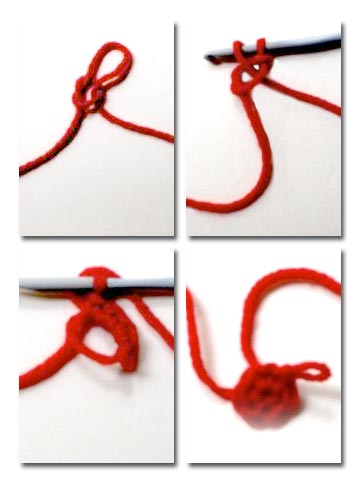CROCHET tips
I am a Knitter. Make no mistake about it. Knitting is my first love. When I was a teenager, though, I taught myself how to crochet. I am a firm believer that crocheters do not have to learn to knit, but knitters should learn to crochet. When you are skilled in both crafts, you do not have to worry about trying to convert a crochet pattern to knit or vice versa. You do not have to skip all of those neat crochet (or knit) patterns available.
So here are a few crochet tips. If any of you have neat tips to share, please email them to Deborah at DeborahKnits@gmail.com.
British vs. United States Crochet Terms
| British | US |
|---|---|
double crochet (dc) |
single crochet (sc) |
half treble (htr) |
half double crochet (hdc) |
treble (tr) |
double crochete (dc) |
double treble (dtr) |
treble (tr) |
triple treble (trtr) |
double treble (dtr) |
miss |
skip |
tension |
gauge |
yarn over hook (yoh) |
yarn over (yo) |
—added April 24, 2013
Single Crochet Foundation Chain: Combine that first chain with your first row, whether it is single crochet or double crochet or more. There are a lot of good videos out there explaining this technique. Here is what I consider one of the best. Your first row will be flexible and stretchy. Dump that chain method of beginning your crochet projects.
For excellent written directions, try futuregirl.
The above are for right-handed crocheters. For left-handed crocheters, click here.
—updated July 12, 2016
Double Crochet Foundation Chain
These directions are based on futuregirl's single crochet foundation chain.
First Stitch
- Chain 2.
- Yarn over and insert hook under top 2 strands of first chain.
- Yarn over, pull through the two strands of the first chain (link).
- Yarn over, pull through one loop (chain)
- Yarn over, pull two loops (first part of double crochet)
- Yarn over, pull two loops (second part of double crochet)
Second and subsequent Stitches
- Yarn over and insert hook in chain part of previous stitch under left and back strands of chain link.
- Yarn over, pull through the two strands of the first chain (link).
- Yarn over, pull two loops (first part of double crochet)
- Yarn over, pull two loops (second part of double crochet)
Thank you, future girl!
—added October 10, 2012
Golden Loop: This is used to help adjust row gauge. (Always check your gauge!) The Golden Loop is the loop that you pull through after you have inserted your hook into a stitch. To adjust your gauge you pull a little more through (or a little less). You have to be sure to be consistent throughout your crocheting or an uneven fabric will result.
 Magic Ring: You know those directions that read: “Chain x, join with a slip stitch. Single crochet (or double crochet, etc.) in the ring.” Here is an easier way to accomplish the same thing. A bonus is that it looks better!
Magic Ring: You know those directions that read: “Chain x, join with a slip stitch. Single crochet (or double crochet, etc.) in the ring.” Here is an easier way to accomplish the same thing. A bonus is that it looks better!
1. Holding the yarn tail in the left hand, make a slip knot with the working yarn. Do not pull it tight; keep it loose. Grasp the loop where the strands meet with your left thumb and index finger.
2. Insert the hook into the knot's loop from front to back and chain 1.
3. Insert the hook into the the loose ring, bring the yarn through the loop from front to back. You now have two loops on the hook. Hook the yarn and bring through the two loops, finishing the single crochet.
4. Repeat Step 3 until you have the required number of stitches. (You will notice that you eventually crochet over the loop and the tail.)
5. Pull the yarn tail tightly to close up the loop. If you have a lot of stitches in the ring, it may not close up completely.
Knitters! Check here for a similar method for casting on a small number of stitches in the round.
Checking your stitch count
- Beginning crocheters, especially, have a problem with not crocheting into the last stitch of a row. Their piece then gets smaller and smaller. So you should check your stitch count after every row. This can be very tedious if you have a hundred or more stitches to count.
- After you have crocheted three or four rows and have counted your stitches, place a stitch marker on the fourth stitch from the beginning and the fourth stitch from the end. On the new row, move the marker up to the stitch you crocheted in these marke stitches. Count your stitches. if your stitch count is correct and you still have four stitches from each end, you have correctly crocheted the end stitches. Repeat for the next row. If, once again, you have the correct number of stitches, you can continue to crochet and count only the first and last 4 stitches.
- It is a good idea to count all of your stitches every 10 or 15 rows.
—added November 30, 2012
